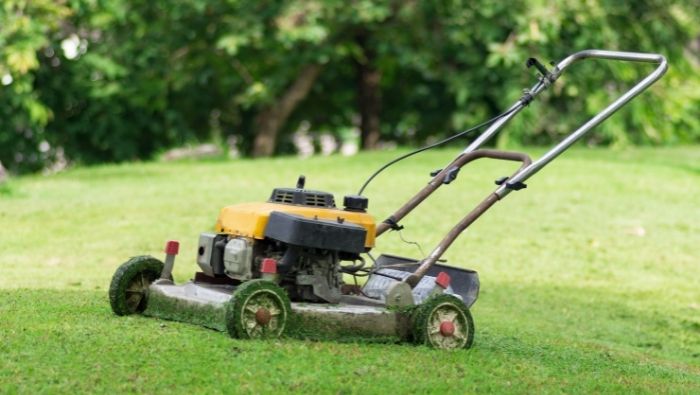Lawn Mower Maintenance for Fuel Savings

The internet and virtually every other media outlet has featured stories on how to boost you car’s gasoline mileage, and that’s terrific.
But what about the other gasoline hog likely living at your house?
I’m not talking about your car(s). I’m referring to your riding mower/lawn tractor. It might be small compared to your SUV, but it’s still a self-propelled motor “vehicle,” so here a few fuel-saving tips for that machine.
Spark Plugs
Most decent-sized riding mowers are powered by two-cylinder engines. Compared to your V-6 equipped road ride, they fire three times as often, meaning on an hour-by-hour basis; the plugs are wearing out three times as fast.
Consult your owner’s manual for the proper replacement interval and change them. You’ll save gas.
Assuming you own a spark plug wrench, replacing a pair of spark plugs will take the average person about ten minutes. Use the exact plug type the engine manufacturer recommends. Don’t substitute another brand.
As a real-world example, my 22-year-old tractor runs best on one specific type, often refusing to start (much less run properly) if I substitute another. The correct plug costs me exactly the same amount as the inferior substitute, and my mower seems to know the difference between the two.
Sign Up for Savings
Subscribe to get money-saving content by email that can help you stretch your dollars further.
Twice each week, you'll receive articles and tips that can help you free up and keep more of your hard-earned money, even on the tightest of budgets.
We respect your privacy. Unsubscribe at any time.
Air Filter
Most riding mowers are equipped with a simple foam air filter element. Replace it when the manufacturer recommends. But, foam is foam, so a knock-off brand will probably work as well as one carrying the manufacturer’s own label. Just change it at the correct interval.
Remember, as a general rule, lawn tractors are touted for their durability, so like the “G-men” supplied shaving razors, mower manufacturers make a ton of money selling their own labeled replacement parts, the same way that outfit in Cincinnati makes a fortune selling replacement blades.
Fuel Filter
Like the air filter, the in-line fuel filter on your mower is designed to trap impurities, particularly the water that accumulates in ethanol-blended gasoline. Replace it on a regular basis, but be smart about it.
Run the fuel tank down to zero and slightly elevate the front of the machine. In-line filters are not fed by a fuel pump. Instead, gravity does the work, so counteracting it with a bit of good planning saves nasty gasoline spills.
And obviously, change the fuel filter outside in a well-ventilated place!
Oil
Motor oil is the life-blood of any internal combustion engine. In a high revving air-cooled model, engine oil burns off and wears out quickly.
Why? Well, for starters, most small 12- to 20-horsepower mower engines are not equipped with oil filters. So check the engine oil level every second or third mowing and change it when the manufacturer recommends.
With our hot but short Yankee summers, I make a point of changing mine midway through the mowing season and just before my mower is tucked away for the winter. And use the recommended weight.
Tire Pressure
Under-inflated tires create more drag, wasting gasoline. Mower tires are usually inflated to about 30 PSI, meaning you can inflate them on your own with a basic bicycle pump.
You do own a bicycle pump, right?
Grease
Unlike modern autos with sealed bearings, most mowers are equipped with grease fittings.
Acquire a grease gun and cartridges and grease the daylights out of everything except the seat. A basic kit will run you about $8, which will pay for itself many times over with the gasoline saved by reducing friction, not to mention the squeaking which might drive a body to distraction.
Related: Preparing Your Lawn Mower for Winter
Belts and Blades
If you’ve got the tools, expertise and muscle, I’d recommend changing your mower deck blades and drive belts whenever they seem worn or stretchy. If not, it’s still cheaper in the long run to have your dealer perform these services, or invite a burly friend over to help.
The less efficiently your mower mows, the more time and gasoline you’ll waste making second passes.
Unlike your car that transports you to work (helping you make money), your riding mower/tractor eats money, giving you nothing in return but a manicured stretch of turf you’ll have to mow again.
Give that machine the care and maintenance it’s rightly entitled too, and put it on a diet, gasoline-wise.
Reviewed March 2023
About the Author
Rich Finzer resides in upstate New York. During his 40+ years as a writer, he has published over 1,200 newspaper, magazine and Internet articles. His books are available on Amazon: Maple On Tap: Making Your Own Maple Syrup, Taking the Tracks, Dawn Toward Daylight, and Julie & Me.
Wouldn't you like to be a Stretcher too?
Subscribe to get our money-saving content twice per week by email and start living better for less.
We respect your privacy. Unsubscribe at any time.
Popular Articles
On After50Finances.com
- 9 Things You Need to Do Before You Retire
- You Didn’t Save Enough for Retirement and You’re 55+
- When Empty Nesters Reorganize and Declutter Their Home
- Reinventing Your Career in Your 50s or 60s
- What Mature Homeowners Should Know about Reverse Mortgages
- 2 Reasons to Collect Social Security Benefits As Soon As Possible

